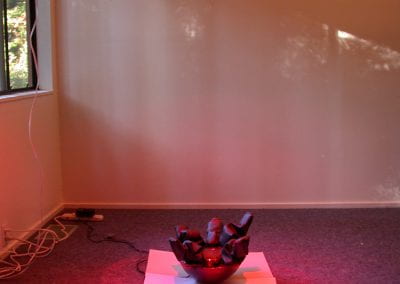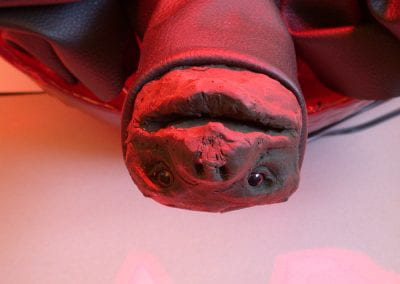
What’s a tortoise
Project description
Robotic Tortoise 2001
What’s a Tortoise? is a test of the emotional response in humans toward a robot. A robot is on its back and placed it under a heat lamp. The robot flails its legs under the heat unable to turn itself over and walk away. The heat that the robot is subjected to will be felt by the viewer as they near the piece. As the viewer approaches the robot will attempt to draw the humans’ attention by increasing the rapidity of its attempts at turning over.
The work is based on the following dialog from the film Blade Runner, where humanoid replicants designed as slaves have freed themselves and have begun developing emotional responses. The “Blade Runner” character is charged with “retiring” the escaped replicants. This dialog opens the film. The replicant Leon is being tested for emotional response to see if he is in fact a replicant.
Holden: You’re in a desert, walking along in the sand when all of the sudden . . .
Leon: Is this the test now?
Holden: Yes. You’re in a desert walking along in the sand when all of a sudden you look down . . .
Leon: What one?
Holden: What?
Leon: What desert?
Holden: It doesn’t make any difference what desert, it’s completely hypothetical.
Leon: But how come I’d be there?
Holden: Maybe you’re fed up, maybe you want to be by yourself, who knows? You look down and you see a tortoise, Leon, it’s crawling towards you . . .
Leon: Tortoise, what’s that?
Holden: Know what a turtle is?
Leon: Of course.
Holden: Same thing.
Leon: I’ve never seen a turtle — But I understand what you mean.
Holden: You reach down, you flip the tortoise over on its back, Leon.
Leon: Do you make up these questions, Mr. Holden, or do they write them down for you?
Holden: The tortoise lays on its back, its belly baking in the hot sun beating its legs trying to turn itself over but it can’t, not without your help, but you’re not helping.
Leon: What do you mean I’m not helping?
In this work I have inverted the test of emotional response. The robot tests the capacity of the human to emotionally respond to its struggle. There are those who claim that robots will either become part of the natural world as “animals” or humanoids. In addition there are theorists who believe that robotic developments are actually a step in human evolution. Robots will adapt and replace humans.
Will a human have an emotional response to the struggling of a robot in the heat? And will robots struggle like humans? Will they end up on their backs flailing about? What do we lose when we lose our ability to fail? Is failure part of the living world? Is empathy toward the other necessary for humans to consider the other as life? Humans adapt like other creatures by manipulating and reconstructing nature. Are robots as out creation part of nature? And if so, do they become that for us because of our empathy toward them? How does empathy construct what is alive and part of the natural world? Do our emotional responses create an ontological category for things as being “alive”? Does it create a “Thou” out of an “it”?
These are some of the questions that this piece poses toward the life-like creations of human technologies. We are in the age of the merging of electro-mechanical technologies with biotechnologies. These technologies reveal deep emotional, ethical and moral questions. There are those who feel that we should relinquish these technological advances because of their effect on humans and the natural world. There are others who feel that this is our Darwinian destiny and that we should not interfere with evolutionary progress. Are bio-electro-mechanical entities our destiny? Do we have any control over our evolution and history? What part do our emotional responses and desires play into the creation of the other, evolution and ourselves?





